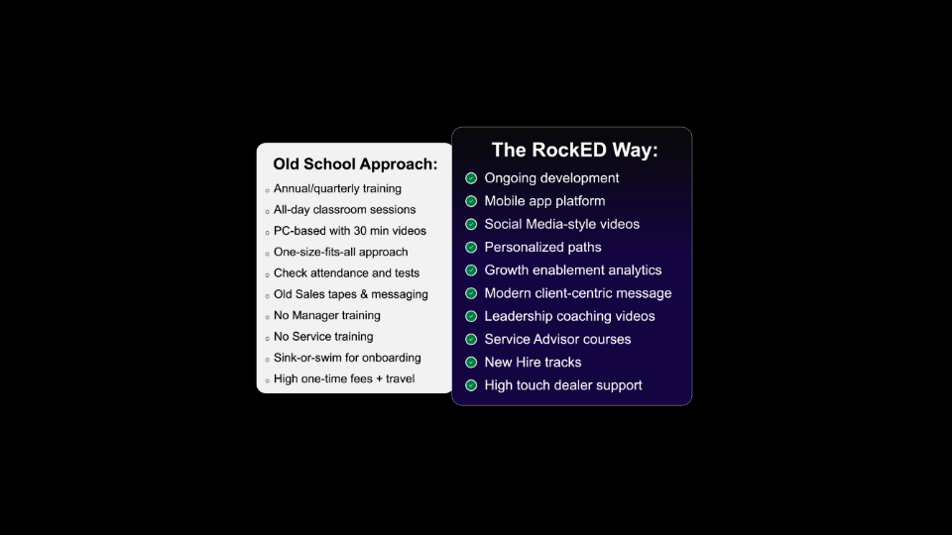What is Broken with Dealership Training and How to Fix it
Dealership training plays a crucial role in the success of automotive sales and service professionals. However, many dealerships still struggle with outdated and ineffective training methods that hinder progress and fail to address the unique needs of dealership staff and departments. This article will explore the ten key problems with current dealership training practices and propose solutions.
1. Event-based training yields very little progress:
Traditional event-based training, such as the annual fire drill to go "Back to the Basics," fails to produce meaningful progress. Instead, a more continuous and ongoing training approach should be adopted, focusing on reinforcing skills and knowledge throughout the year.
Solution: Implement a regular training schedule with shorter, more frequent sessions for consistent skill development and retention. This approach ensures that the training becomes a continuous process rather than a one-time event.
2. All-day training takes your dealership team off the floor or drive:
Conducting all-day classroom sessions can disrupt the daily workflow of dealership sales and service teams. Pulling employees away from their desks for extended periods can lead to lost productivity and missed opportunities.
Solution: Embrace a blended learning approach combining digital learning, team or group exercises, and shorter in-person coaching sessions. This way, training can be integrated into the regular work schedule, minimizing disruption in the dealership while maximizing engagement and knowledge retention.
3. PC-based training with 30-minute videos is not sticky:
Static, long-form videos on a computer screen often fail to engage dealership learners effectively, leading to limited retention of information.
Solution: Instead, utilize interactive and engaging training content, such as gamification, simulations, and bite-sized modules. Incorporate hands-on exercises and real-world scenarios to enhance learner involvement and promote better information retention.

4. One-size-fits-all does not make training relevant:
A uniform dealership training program may not address individual team member's unique needs and skill gaps, resulting in suboptimal performance.
Solution: Customize training programs to cater to the specific requirements of different roles and skill levels within the dealership. Offer personalized learning paths that allow employees to focus on areas where they need the most improvement, enhancing overall effectiveness.
5. Dealership managers rarely receive leadership training:
Promoting high-performing individuals into managerial positions without adequate training can lead to ineffective leadership and reduced team performance.
Solution: Develop comprehensive training programs for managers to equip them with the skills to lead, coach, and mentor their teams effectively. Invest in ongoing management development initiatives to ensure continuous growth and enablement.
6. Dealership Service training is neglected:
Service departments are often overlooked in training, despite their critical role in customer satisfaction and revenue generation. That may have to do with their wild schedules.
Solution: Establish dedicated training programs for dealership Service Advisors focusing on technical knowledge, customer service skills, and efficient processes. Dealerships can enhance customer experiences and drive loyalty by investing in developing service teams.
7. Shadowing veterans is not a dealership onboarding plan:
Relying solely on shadowing experienced dealership professionals as an onboarding strategy can result in an inconsistent and unstructured learning experience for new hires.
Solution: Implement a structured onboarding plan combining shadowing and formal training sessions. Provide new employees in your dealership with access to comprehensive resources, mentorship programs, and clearly defined learning objectives to accelerate their integration into the dealership.
8. Modern retailing is not learned from old Sales tapes:
Using outdated training materials, such as old sales tapes, fails to address the evolving needs of the modern automotive industry.
Solution: Revamp training materials to reflect current market trends, customer preferences, and sales techniques. Incorporate technology-driven tools and methodologies to equip sales teams with the skills necessary to excel in today's digital retailing landscape.
9. Checking training attendance does not support progress:
Merely tracking training attendance and administering tests do not provide meaningful insights into progress or address individual development needs.
Solution: Implement performance-based assessments and practical evaluations to measure the application of knowledge and skills acquired during training. Provide constructive feedback and coaching to dealership Sales and Service based on their performance, fostering continuous improvement.
10. In-dealership training from consultants is expensive:
Engaging external consultants for in-dealership training can be costly, and the effectiveness of such programs is often unclear or nebulous. Additionally, dealers inadvertently remove accountability from their leadership team to develop their people.
Solution: Consider investing in internal training resources and expertise for your dealership to develop and deliver tailored training programs. By leveraging the knowledge and experience within the dealership, training efforts can be more cost-effective and closely aligned with organizational goals and culture.
Conclusion:
Dealership training must evolve to address the challenges and opportunities of automotive sales and service professionals. By adopting a more continuous, personalized, and engaging training approach, dealerships can foster a culture of learning and development that enhances employee performance, customer satisfaction, and overall business success. Embracing modern training methodologies and leveraging internal expertise will empower dealership teams to thrive in an ever-changing automotive landscape.
